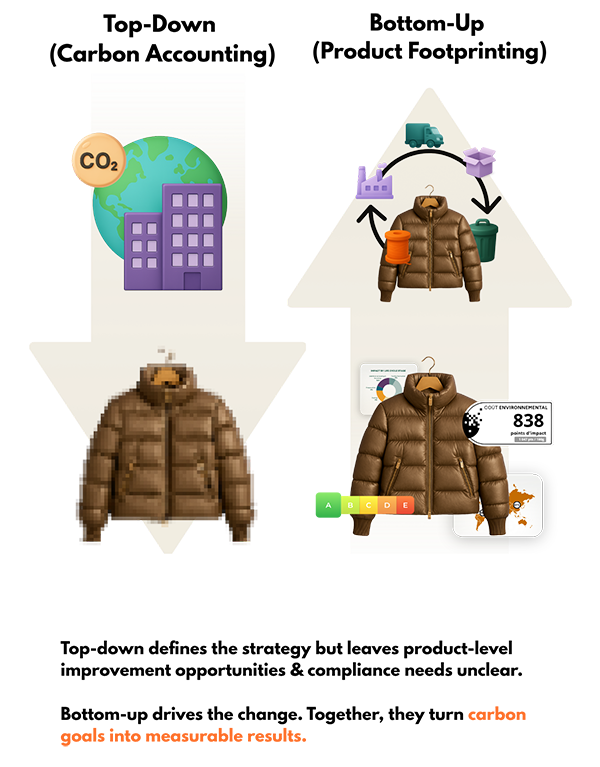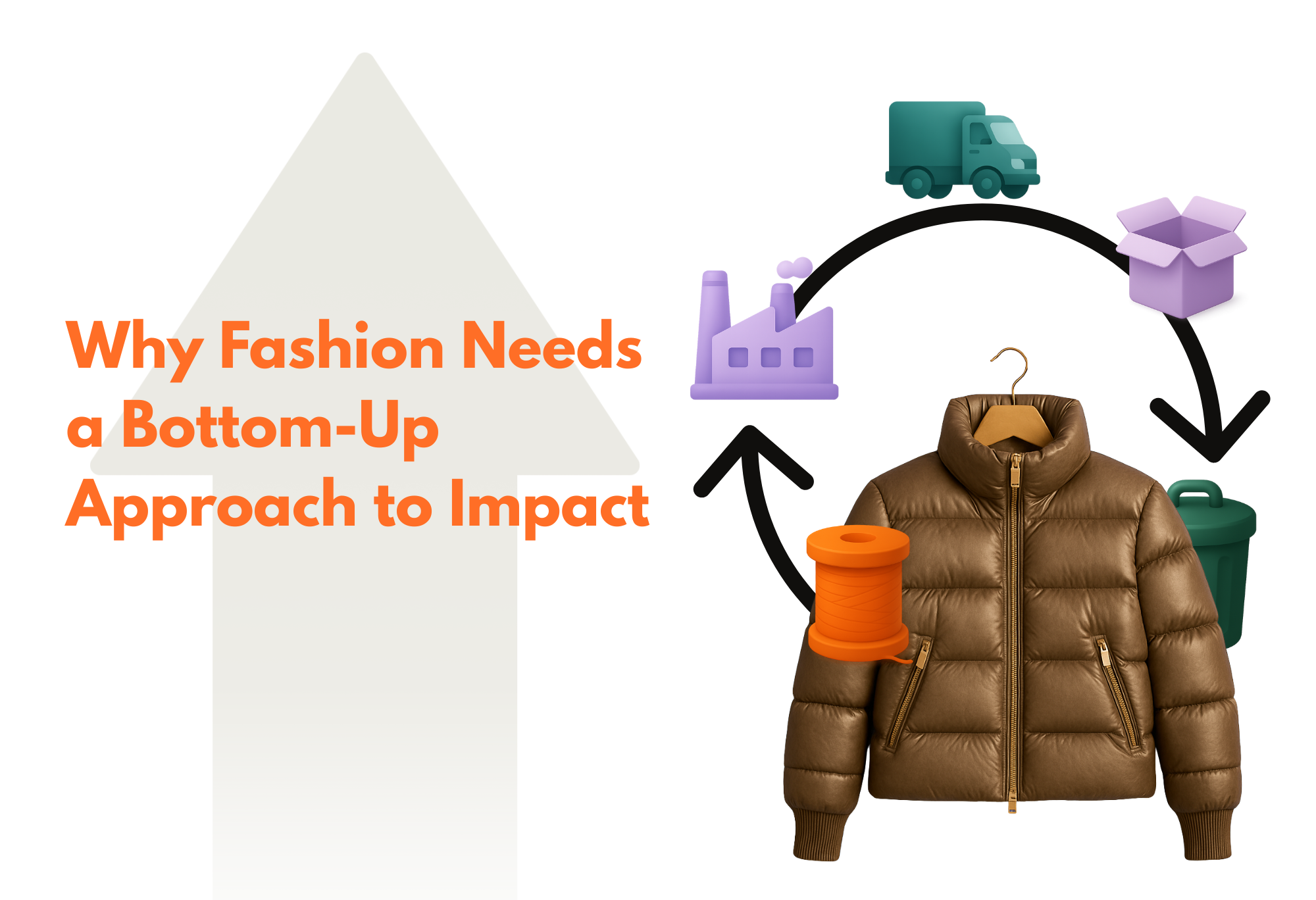Why the EU Is Raising Sustainability Requirements
Fashion and lifestyle brands in Europe are facing mounting pressure to demonstrate genuine sustainability performance, not just marketing rhetoric. Under the European Green Deal and its related frameworks, the European Union is systematically tightening sustainability standards to make products more circular, transparent and resource-efficient.
From the EU Strategy for Sustainable and Circular Textiles to the forthcoming Ecodesign for Sustainable Products Regulation (ESPR) and the Digital Product Passport (DPP), policymakers are setting clear expectations: brands must not only claim but also prove the sustainability of their products.
By 2030, the EU expects all textile products on its market to be durable, repairable, recyclable and made primarily from recycled fibres – a central goal of the EU Textiles Strategy. However, amidst this regulatory momentum, many brands often conflate two fundamentally different approaches: corporate carbon accounting and product-level life-cycle assessment (LCA). The result is a gap between strategy and action, leading to inconsistent reporting, poor design choices and regulatory risk.
“Corporate carbon accounting and product-level LCA serve two very different purposes, one measures organisational performance, the other guides product design.” Laurent, Bocahut, CEO
What’s the Difference Between Carbon Accounting and Product LCA?
The Macro Lens – Corporate Carbon Accounting
Corporate carbon accounting measures the carbon emissions of an organisation, capturing both direct and indirect emissions. Emissions are classified into three scopes:
- Scope 1 encompasses direct emissions from on-site sources, such as manufacturing facilities and company vehicles
- Scope 2 accounts for indirect emissions resulting from electricity and energy usage
- Scope 3 is a broad category that includes all other indirect emissions (not included inScope 2) that occur in the company’s value chain, including business travel and the end-of-life treatment of sold products.
By regularly assessing their corporate carbon footprint, businesses can understand and analyse the carbon impact of their operations, supply chains, products and services. This tool is crucial for setting climate strategies and establishing science-based targets aiming to reduce carbon emissions.
It forms the backbone of disclosures required by frameworks such as the EU Corporate Sustainability Reporting Directive (CSRD) and the Greenhouse Gas Protocol.
⮩ However, its focus is organisational rather than product-specific. Whilst tracking emissions is beneficial, it does not furnish stakeholders with meaningful insights at the product level. These aggregated emission metrics demonstrate the overall corporate performance but lack the detail necessary to determine whether a particular jacket, shoe or handbag is environmentally preferable to another, thus lacking the granularity to guide design or sourcing decisions effectively.
The Micro Lens – Product-Level Life-Cycle Assessment (LCA)
A product-level life-cycle assessment (LCA), on the other hand, takes a cradle-to-grave view of a specific item, evaluating its complete environmental footprint across multiple impact categories (for example, climate change, water use, resource depletion, eutrophication), from raw-material extraction to manufacturing, transport, use and end-of-life.
The European Commission’s Product Environmental Footprint (PEF) initiative and Product Environmental Footprint Category Rules (PEFCRs) for textiles and footwear provide harmonised guidance for this purpose.
Product-level LCA turns visibility into action. While carbon accounting provides visibility into overall emissions, product-level Life Cycle Assessment delivers actionability. It enables designers, developers, and suppliers to pinpoint environmental “hotspots” from materials, dyeing, assembly, and transport to packaging and compare alternatives with precision.
⮩ Because 80–90% of apparel’s impact lies within products and their supply chains, not in offices or electricity use, product-level LCA offers the granularity needed to design smarter and reduce impact where it truly matters. It forms the scientific backbone of credible eco-design, transforming data into informed, measurable decisions.

Why Product-Level Impact Matters
Seeing Beyond Corporate Averages
The distinction between carbon accounting and product-level LCA lies in granularity and that difference matters. Without it, companies risk acting on incomplete insights and missing the true levers of impact reduction. Organisation-wide figures may show progress, yet they can mask where most emissions actually occur: in materials, dyeing, assembly, transport, and packaging .
Identifying Real Environmental Hotspots
Without product-level data, brands remain blind to the real “hotspots” in their collections. A fibre switch say, from cotton to organic cotton might look like progress, but its impact depends entirely on farming methods, regional practices, dyeing processes, and logistics. The same design, produced by two suppliers, can have entirely different environmental footprints.
As regulations evolve, the stakes are rising. Companies will need verifiable, product-level evidence, not broad corporate averages, to prove improvement, maintain credibility, and focus efforts where they count most in the product and its supply chain.
EU Regulations Now Require Product-Level Evidence
End of Unverified Claims
Beyond voluntary good practice, EU-level instruments now demand product-level information in many contexts. European regulators are taking steps to prevent vague or unsubstantiated claims, mandating life-cycle substantiation where applicable. The European Commission’s Green Claims Directive proposal (COM/2023/166) reflects this intent.
The proposal, which the European Commission initially published in March 2023, requires that all environmental claims be substantiated by recognised, verifiable methodologies, typically based on LCA to avoid greenwashing.
⮩ Even though the proposal’s legislative future remains uncertain, as the Commission announced its intention to withdraw the proposal in June 2025 for revision, its core principles and objectives continue to influence both EU and national initiatives aimed at improving transparency and substantiation of sustainability claims.
ESPR and Digital Product Passport – Product Proof Required
The ESPR, a central pillar of the Green Deal, will require all major product categories, including textiles, to meet mandatory criteria for durability, repairability and recyclability. The Regulation will also introduce Digital Product Passports (DPPs), which will carry verified environmental data throughout a product’s life cycle. At the same time, the Commission and stakeholders have advanced PEF/PEFCR for apparel and footwear to create a harmonised LCA methodology across the single market.
Similarly, the EU Strategy for Sustainable and Circular Textiles calls for traceable, circular products and the introduction of a legal framework for treating and managing waste and discouraging the destruction of unsold or returned stock. These policy moves make one thing clear: sustainability must be evidenced at the product level, not extrapolated from corporate-level averages.
Avoid Compliance Fatigue:
The policy landscape is not yet fully harmonised. Whilst the European Union regulations are shifting from voluntary reporting to mandatory redesign, national initiatives, most notably France’s score environnemental for textiles, add another layer of complexity, as their methodologies remain uncertain and not yet aligned with PEF standards.
Such regulatory plurality creates confusion amongst brands about which legal standard will ultimately prevail across the EU. Without harmonised indicators, brands face “compliance fatigue” chasing multiple requirements with overlapping metrics and disconnected datasets.
⮩ The solution is to choose a product-level measurement backbone now that can power all frameworks from a single, reliable dataset. That’s precisely what PEF-based product assessment enables: one methodology, many outputs ensuring consistency, credibility, and readiness for whatever regulations come next.
Why Brands Need Both: Carbon Accounting + Product-Level LCA
Corporate carbon accounting and product-level LCA are not competing tools; they are complementary.
Carbon accounting provides the strategic direction to set high-level targets (for example, 50% reduction in Scope 3 emissions by 2035), aligning corporate action with the EU Climate Law target of net-zero by 2050.
Product-level LCA delivers the operational insight, showing how each product can be improved to achieve those goals.
Bottom-Up Sustainability – The Smart Approach
How Peftrust Bridges the Gap
One sets direction, the other identifies the steps to get there, and when linked effectively, these two perspectives create a feedback loop between design, sourcing and sustainability strategy. Peftrust bridges this methodological gap between corporate and product-level sustainability.
Its digital platform integrates product-level impact data directly into reliable metrics for strategy, reporting and eco-design. It enables fashion and lifestyle brands to navigate the current regulatory fog and prepare for what’s next, all the whilst following a bottom-up approach.
⮩ A bottom-up approach begins with verified, product-level data and builds corporate metrics from that foundation. This method is more constructive and resource-efficient because it ensures that company-wide reporting reflects real, measurable product impacts rather than extrapolating product assumptions from corporate averages. It creates a transparent trail from material choice to market impact, one that can populate the ESPR and DPP frameworks with consistent, verifiable data.
“Real impact lives in the supply chain. Product-level data connects directly to mills, dye houses and factories, basing impact and sustainability on evidence, not assumptions.” – Denby Royal, Head of Sales, Peftrust
Conclusion – From Reporting to Redesign
European sustainability policy is transforming the way fashion operates, from transparency obligations to product circularity requirements. The shift is clear: from reporting to redesign.
Corporate carbon accounting alone cannot guide product decisions because it overlooks where most emissions occur: in product design and supply chains. To thrive under the evolving regulatory regime, brands must integrate both lenses of sustainability measurement: the corporate lens to meet strategic and reporting obligations; and the product lens to drive real environmental improvement. The antidote is a measured, bottom-up approach: robust product LCAs, aligned with PEF/PEFCR where relevant, aggregated to provide transparent corporate metrics.
⮩ With Peftrust, product impact becomes corporate insight. We aggregate product and facility data into consistent Scope 3 metrics, giving brands traceable reporting insights and the power to eco-design products with measurable impact.
Ready to future-proof your sustainability strategy?
Book a demo with Peftrust and turn product impact into corporate insight.
